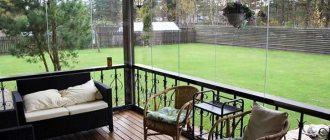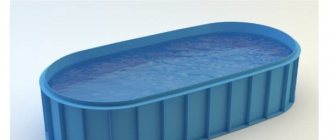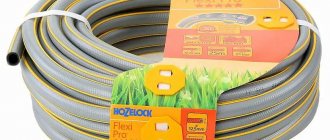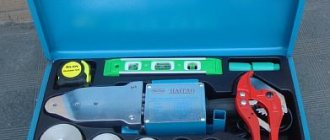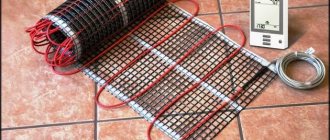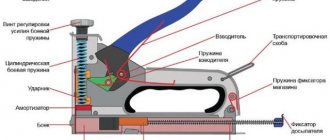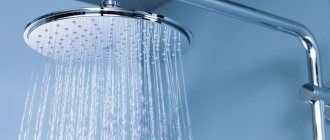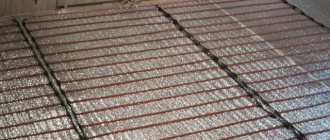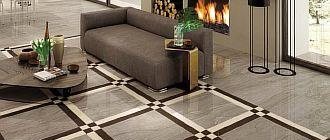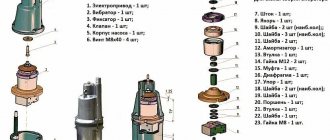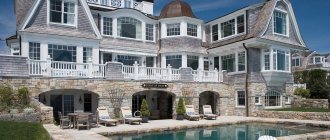Polycarbonate is a universal material that is widely used to create stops, canopies, other structures and decorative finishing of buildings. Now one of the popular solutions is the facade of a house made of polycarbonate , which is a side light structure.
Translucent structures are created to ensure maximum natural lighting in the premises. This element gives the building a non-standard appearance and allows you to visually expand the interior space .
Unlike glass, soft, diffused light comes through polycarbonate , which creates comfortable conditions for vision. From the outside, the panels have an attractive appearance, therefore they serve as a decorative finish.
A design feature of the panel facade is the absence of longitudinal elements , which significantly reduces the weight of such a structure and allows installation in a short time.
Monolithic facades are often used in the construction of multi-storey buildings, large-scale sports buildings, shopping and entertainment centers, as well as buildings with non-standard architecture .
Types of polycarbonate
There are monolithic and cellular polycarbonate, differing in the structure of the sheet. Monolithic - a solid mass, reminiscent of glass. Cellular - with hollow cells, between several layers of plastic.
Polycarbonate belongs to the category of thermoplastics. They are made from granules using special equipment using the extrusion method. To do this, the granules are heated to the melting temperature, then a sheet is formed. The plastic hardens quickly, literally in seconds. Immediately after molding, a protective layer is applied to protect the material from exposure to ultraviolet radiation. Polycarbonate quickly deteriorates and becomes brittle under the influence of UV. The presence of a protective layer of 50-80 microns prevents this process and extends service life.
UV protection Source moypolikarbonat.ru
Depending on the raw materials and production conditions, plastic with different technical characteristics is obtained.
Monolithic polycarbonate
This type of polycarbonate is sometimes called "impact glass". A high degree of light transmission is combined with strength, but is almost 200 times superior to glass in terms of the latter indicator. They produce sheets with thicknesses from 1.5 mm to 15 mm. There are smooth cast, monolithic polycarbonate and with stiffeners, corrugated. It is stronger than a simple monolithic one, bends easier, and can withstand significant loads. Can be rolled up for easy transportation. In appearance it resembles a profiled sheet.
Profiled sheet Source best-stroy.ru
Smooth sheets are bent to the minimum permissible degree of cold bending, depending on the thickness. Complex shapes that exceed the bending radius are produced by thermal molding.
The main advantages of monolithic polycarbonate:
- High strength. Withstands significant snow, wind, and mechanical loads. A fallen branch will not cause damage to the structure. With a thickness of 12 mm, it is not destroyed by a bullet fired from a Makarov pistol.
- Resistance to many aggressive environments: fats, oils, acids (organic, inorganic), solutions with salt.
- Easy to clean with soap solutions.
- The material is flexible, so it is possible to manufacture arched structures.
- Thermal conductivity and sound insulation are better compared to glass. Cast polycarbonate does not break into small fragments. Absorbs up to 35dB (thickness 2-4mm). Often used in airport building structures.
- Having light conductivity comparable to glass, monolithic plastic is much lighter.
- Withstands a range of temperatures from low (-50⁰С) to high (+130⁰С).
Standard size of cast polycarbonate sheet: 2050 x 3050 mm; 1220 x 2440 mm; 2050 x 6100 mm.
Sheet sizes Source bouw.ru
Flaws:
- quite high cost;
- not resistant to methyl-containing liquids; ammonia solutions; alkaline environment.
- Scratches may remain on the surface after mechanical impact.
Ultraviolet protection is provided by applying a special film and adding stabilizers to the plastic mass.
Depending on the color of the material, light transmission changes. Transparent plastic has up to 90%, bronze – up to 50%.
Monolithic sheets Source tdvasya.ru
Which polycarbonate is best for a cast polycarbonate canopy. First of all, it depends on the size of the structure. From 2 to 4 mm are used for small canopies and bent structures. From 6 mm to 8 mm for fairly large structures with requirements for wind, snow, and mechanical loads. Cast polycarbonate 10 - 12 mm is used under conditions of extreme loads.
Cast polycarbonate is:
- transparent (about 90% transmits light);
- translucent (up to 45%): colored polycarbonate:
- milky, pearl (up to 25%), these include silver and gold plastic.
Transparent monolithic plastic Source www.polikarbonat.hu
In the question of polycarbonate for a canopy, which one to choose is based on the degree of light transmission. Transparent molded plastic is used when maximum light penetration is needed. For example, in greenhouses, when polycarbonate replaces double-glazed windows. Translucent canopies create a shadow effect. The color is chosen individually, depending on the design solution and the purpose of the structure. Blue and turquoise sheets are suitable for covering a pool. The range of yellow and brown is used for carports. Opaque polycarbonate (25%) is used for structures where minimal light penetration is required.
Brown polycarbonate canopy Source i.ytimg.com
Which polycarbonate to choose for a terrace roof, you need to decide not only on the thickness of the sheet, but also on the ability of the polycarbonate to transmit light. If the terrace faces south, it is advisable to use translucent polycarbonate to shade the area. On the north side, opposite, it is transparent.
Cellular polycarbonate
What thickness of polycarbonate is better to use for a canopy, cast or honeycomb. You can choose any type, the main thing is that its technical characteristics correspond to the calculated loads. Cellular plastic has advantages; it is cheaper and lighter in weight than monolithic plastic.
Inside the cellular polycarbonate, between layers of plastic, there are stiffening ribs of various shapes. Depending on the thickness of the sheet, the configuration of the ribs, and the number of layers, the technical characteristics of the material change, namely: thermal conductivity, noise insulation, strength.
Canopy made of honeycomb plastic Source vorota2003.ru
Main types of cellular polycarbonate:
- Two-layer, rectangular honeycomb (thickness from 0.4 to 10 mm), marked 2H.
- Three-layer, with rectangular and beveled stiffeners (3X).
- Three-layer with rectangular stiffening ribs (width 6; 8; 0 mm) – 3H.
- Five-layer, rectangular ribs (from 15 to 20 mm) – 5W.
- Five-layer, combined, with rectangular and beveled ribs. Reinforced, thickness 25 mm, 5X.
- Six-layer, combined with straight and beveled ribs - 6 RX.
The higher the thickness, the greater the strength, the less windage, impact resistance, and heat capacity. But at the same time, the coefficient of light transmission and the minimum permissible degree of bending decreases.
Honeycomb material Source materialexpert.ru
The question arises, what thickness of monolithic polycarbonate is best to use for a canopy. It is necessary to find the optimal ratio of strength and light transmission, depending on the design loads. Small canopies over the porch, entrance, with a significant bending radius are made of cellular polycarbonate 4; 5; 6 mm (2 or 3 layers). For carports and terraces of a sufficiently large area, cellular polycarbonate 6 is used; 8; 10 mm.
Carport Source budshop.com.ua
Please note, when answering the question, which polycarbonate is better for a veranda, you need to take into account that molded plastic is stronger and transmits light better.
What color of polycarbonate is better to choose for a canopy? Does coloring affect the ability of polycarbonate to transmit light? Dark colors diffuse light. It is not recommended to use the crane and orange spectrum for canopies in sunny areas. Polycarbonate quickly warms up, the air heats up, and it becomes hot. In a swimming pool covered with blue honeycomb plastic, the water will take on a sea-green hue.
Pool canopy with blue honeycomb plastic Source polikarbonatvs.com.ua
Advantages of cellular polycarbonate:
- Thanks to the hollow cells, the material gains additional strength, but remains lightweight. This makes it possible to use a lightweight supporting structure and save money.
- Stiffening ribs increase the minimum permissible degree of bending.
- Cellular polycarbonate 6-10 mm can withstand quite serious loads.
- Color and species diversity.
- The safety of canopies, unlike glass, does not break or break into fragments.
The disadvantages are the same as those of cast polycarbonate, but the cost is lower.
Types of cellular polycarbonate Source st1.stpulscen.ru
How to replace polycarbonate for a canopy, what alternative options are offered on the construction market. Canopies are made from roofing materials. For example, from bitumen coatings on a continuous sheathing, it is good to bend. They use profiled sheets, but they get very hot and have poor sound insulation. All roofing materials do not transmit light. In terms of strength and degree of bending, cellular polycarbonate is not inferior to roofing coverings; the canopy and terrace are better lit in the daytime.
Field of application of polycarbonate
After its appearance on the construction market, polycarbonate became popular. But under the influence of UV rays it became brittle and quickly collapsed. Therefore, the wave of interest in the material has subsided somewhat. Only when new types with a protective coating appeared and a stabilizer against ultraviolet exposure began to be added, the material again became in demand.
Material with UV protection Source zuker.by
Scope of use:
- awnings, canopies in private public buildings;
- stops, covered walkways;
- shop windows, façade glazing;
- covered parking lots;
- terraces, verandas, balconies;
- covering municipal and public buildings, bus stations, airports;
- glazing of greenhouses, winter gardens, greenhouses.
Another advantage of polycarbonate is the ease and speed of installation. The components, profiles, and fasteners greatly simplify the work.
See also: Catalog of companies that specialize in roofing materials and attic floor reconstruction
Arrangement rules
The creation and construction of a roof has a number of nuances and features, including:
- The roofing material of the veranda must be exactly the same as for the roof, so that a single building is created in a simple style.
- The roof of the veranda should ideally be pitched, so it will serve as a continuation of the roof of the house and will not allow snow masses to accumulate on its surface.
- In order for the wooden roof frame to last for a long time, be fireproof and resistant to fungus, it is treated with special impregnations that protect wood species.
- For the safety of household members, the slope is positioned in such a way that snow masses from it do not fall on the side of the entrance to the building. During the winter period with heavy precipitation, there is a risk of spontaneous snow falling; if the roof is positioned incorrectly, then household members may suffer or be injured.
- The distance between the rafters, the quality and density of the sheathing depend on what roofing material is chosen. The main conditions put forward for the roof are reliability, functionality and complete insulation.
- It is necessary to carefully lay a layer of waterproofing, since this building must be reliable and well protected from moisture and leaks.
Components, installation features
Before deciding what thickness of polycarbonate to choose for the canopy, you need to make a project and calculate the materials based on it. It is better to use the services of professional builders. You can use online calculators for these purposes.
The calculator will help you calculate the approximate number of polycarbonate sheets Source polycarbonat-rostov.ru
Any structure consists of a supporting structure and a polycarbonate coating.
The supporting structure includes supports and a frame for attaching polycarbonate. Made from metal, aluminum profiles, wooden beams. Regulated by regulatory construction acts and SNiP rules (2-523-81 for steel structures; 3.04.03-85 – corrosion protection).
The main components are made of polycarbonate and aluminum profiles.
Details for installing polycarbonate:
- profile: end, connecting, adjacent, corner, ridge, clamping strips.
- thermal washers with silicone gasket;
- seals, end tapes.
End profile Source baumaster69.ru
Polycarbonate expands as a result of temperature fluctuations. Due to the high coefficient of thermal expansion, a gap of 3-3.5 mm is made between the sheets of material. The hole for the fastening is drilled a few millimeters larger.
The standard length of cellular plastic sheets is 6 and 12 m, width 2.1 m. Profiles are produced in accordance with the size of polycarbonate - 6 m.
Installation diagram Source sadov0d.ru
Types of profiles:
- Connecting profiles in the shape of the letter “H” are one-piece, detachable from 2 parts of the base and cover. The base is screwed to the longitudinal guide bars of the frame. The roof snaps or screws onto the base.
- Adjacent in the shape of the letter "F". Installed in places adjacent to the wall. Attached with self-tapping screws or sealant.
- The corners are connected with a special profile made of plastic or aluminum. They produce corner profiles with different degrees of slope.
- If the roof shape has slopes, a ridge profile is installed at the joint junctions.
- The end plate in the shape of the letter “P” acts as a plug. It is installed along the edge with an indentation, a hole is made in it so that the moisture accumulated inside the honeycomb flows to the ground. Before installing the plank, end tape is glued to the end, preferably with perforated holes.
- Pressure profile or strip. They are usually made from aluminum. Additionally, the sheet is fixed.
Components for polycarbonate Source rs36.rf
General recommendations
The best option would be to design a veranda at the stage of building a house. If this failed and a private house has already been built, then you will have to make a kind of extension and think about organizing its roof.
Recommendations for building a veranda near a finished house:
- It is necessary to use materials that were used to build housing.
- If the house is built of wood, then it will take 2-3 years for complete shrinkage, which means that adding a veranda before this time is not recommended.
- It is necessary to make an internal exit so that you can enter the veranda from the kitchen or other adjacent room.
- The foundation and roof must be uniform.
- The length should correspond to the length of the wall to which the veranda is attached, and the width should be no more than 2.5 meters.
Selection of quality material
How to choose polycarbonate for a canopy, what you need to pay attention to.
The sheet is covered on both sides with self-adhesive film. The back side, which is attached to the frame, is transparent. On the outside - colored, with the company logo, markings, indicating the thickness of the protective layer. Before installation, only the bottom transparent film is removed. With an indentation of 10 cm around the perimeter of the sheet, wrap the film with the logo. This is necessary so that it does not interfere with installation work. It is finally removed after installing all the sheets. This sequence eliminates the possibility of confusion between sides with and without UV protection.
The outer side of the sheet with the logo Source profistroy-ekb.ru
Types of application of a UV protective layer:
- Spraying. Not a very reliable method. Under the influence of mechanical, snow load, it collapses over time, approximately 3-4 microns per year. Accordingly, the service life is reduced.
- By extrusion method. It is applied immediately to plastic that has not yet cooled down, soldered to the surface, a more reliable coating.
- Adding a special stabilizer to the mass of granules (up to 30% of the total mass). This protection makes the material resistant to UV radiation and is guaranteed to last 10-15 years or more. But the cost also increases.
The second important point is the density of the material. According to existing standards, for a certain type of polycarbonate, its thickness corresponds to the weight of the sheet. Sometimes, manufacturers of low-quality plastic ignore these recommendations in order to reduce costs. The layers and stiffening ribs of the honeycomb are made thinner. When squeezed with your fingers, the honeycombs collapse. When a piece of material is bent, a characteristic crack is heard, and microcracks may appear. High-quality polycarbonate is difficult to press with your fingers; it bends quite hard. When installed on an arched structure, it acquires additional strength due to the internal pressure of the sheet.
Varieties
Sheds are usually located in high-traffic areas. You can place them above the stairs or steps, adapt them to grapes, or take them out into the backyard.
The uses of such structures are varied. They are used above a parking lot, to cover play areas, a swimming pool or shower, and also as a reliable shelter over the porch.
- Canopies in the form of a canopy are used to shelter the surrounding area from bad weather conditions. This is an excellent option for protecting steps and thresholds from freezing in winter, which will help prevent falls and injuries.
- The extension model allows you to place comfortable wicker furniture, a barbecue grill, and a swing under it. It is customary to make such shelters in the same style as the house, using similar materials and colors. Typically, the structure of such a canopy is quite large, so one side of it is attached to the wall of the building, and the other is placed on supports. But there are also stationary canopies that have supports on each side, or mixed models. Such buildings have many advantages. You can walk under the canopy at any time of the year without fear of rain or heavy snowfall.
- Gazebo canopies are the most popular option among homeowners. Such gazebos can have different shapes and types. Most often you can see round and square models, there are also models in the form of a polyhedron. Designs can be open or semi-closed. Open gazebos usually have a support and a roof, while semi-enclosed models have side walls. The best place to place such structures is in picturesque green areas or hills.
- Models placed above children's playgrounds are also very popular. If there are small children in the house, they will be able to play outside on swings, sandboxes, horizontal bars and slides in any weather. At the same time, the structure itself will additionally protect the playground from the negative effects of temperature and humidity, which will extend the service life of such products.
- A canopy placed over the pool will make it possible to use it regardless of the weather. Such buildings can be permanent or collapsible.
- Another type of similar structures are awnings, which are awnings made of thick fabric on a retractable structure. Typically used for balconies, windows, terraces and gazebos as protection from scorching sun rays. Their advantage is the ability to regulate the amount of opening.
If you have a car, a canopy in the yard will protect it from bad weather conditions and the scorching sun. This option is very convenient when guests arrive or when there is no garage in the house.
Video description
Tips for choosing polycarbonate in this video:
The problem with choosing a quality material is that it is not always possible to check all the parameters by inspection. For example, how to determine the degree of UV protection. This can only be done in laboratory conditions. Therefore, preference should be given to polycarbonate from well-known, time-tested brands. A low price may be a signal of a low-quality product. It is better to choose the “golden mean”.
High-quality material Source polidin.ru
Beautiful examples
There are many beautiful examples showing how to design a structure.
- Forged models will go perfectly with a stone or brick wall of the house.
- Carved wooden gratings are suitable for canopies made in eco-style.
- LED lights installed around the perimeter or in the center of the building will help add airiness.
- Climbing plants and flowerpots with flowers will decorate the structure and give it elegance.
- Original flower arrangements and clay products will help give your gazebo a cozy look.
- Installing a barbecue or barbecue grill under a canopy will allow you to cook delicious dishes there. In such a gazebo it is nice to spend an evening with friends or play with children. It is worth putting a barbecue or grill under the canopy. If space allows, you can install a decorative waterfall or fountain here.
- A convenient carport can be a worthy alternative to a garage.
To learn how to make a forged canopy in the courtyard of a private house, see the following video.
How to care for polycarbonate structures
Pre-purchased sheets of plastic are stored in an even stack, preferably in a shaded place. It is recommended to cover them with fabric material. Make sure that the edges do not hang down or bend.
Installation rules must be followed. Resistance to loads, snow, wind, and mechanical depends on how securely the structure is installed and secured. The joints and the end of the cellular polycarbonate are especially carefully sealed to avoid the accumulation of moisture, dust, and small debris inside the sheet.
The recommended slope angle of the canopy is at least 6%. The end profile is attached with a gap, holes are made in it to collect and remove water.
Holes for attaching sheets to the frame according to the drawing markings can be pre-made on the ground. The installation process will be accelerated and the traumatic load on polycarbonate during installation work will be reduced.
Correctly mounted canopy Source sevkarbo.ru
Even with the correct calculation of loads, it is better to clear the structure of snow and debris falling from trees during operation.
Wash the sheets with non-aggressive detergents, using a soft cloth or sponge. The use of abrasives, hard brushes, and metal brushes is excluded. Scratches may remain on the sheets and they become cloudy.
Washing polycarbonate with a soft brush Source i.ytimg.com
How to choose polycarbonate for a canopy and which type is best to use is decided based on the features and stylistic features of the structure using this material. The design should fit organically into the overall conceptual design solution. Traditionally, plastic is chosen that intertwines with the textures of the main roofing materials. For example, if the roof is made of corrugated sheets, then it is logical to use profiled injection molded polycarbonate. The color is chosen to match the tone of the main roof. The second decisive factor is area, design features, technical calculations of loads. They are the ones who determine the thickness of the sheets.
Terrace in a modern style Source it.conceptualhouseplans.com
Fundamental questions
If the foundation was not originally shared with the house, then make it as strong as the scale of the extension requires. For a massive stone veranda, it is better to build a strip one, for a log house - a columnar one, and for a frame - a perimeter beam.
Here is a good example of how to build a strong columnar foundation:
- Step 1. We dig holes in the ground up to 1 meter deep.
- Step 2. Next, we install pipes from rolled roofing felt in them.
- Step 3. We pour sand inside these pipes and then pour concrete. In the process, we pat these pipes on the sides, thereby replacing the work of the vibrator.
- Step 4. Now we install the ceiling. To do this you will need 6 bars 50x150 and 8 bars 50x100 two meters each. We make the ceilings along the contour, and in the middle of the beams, with a span between the boards of about 1 meter.
- Step 5. Now we lay down the floor boards, for which it is most convenient to use a regular inch.
Here's what it looks like in practice:
With walls it’s even easier; such a veranda is built no more difficult than any other extension:
Briefly about the main thing
You can build and assemble a canopy or terrace in just a few days, thanks to quick installation. Does not require labor-intensive care.
Plastic is selected based on the structural features of the canopy and technical load. Depending on the color of the polycarbonate, light transmission changes, which must also be taken into account.
Polycarbonate is a beautiful, lightweight, light-transmitting material. The variety of types and technical characteristics make it possible to select it for different types of structures.
Ratings 0
Style directions
A correctly chosen design of the structure will allow it to fit best into the overall architectural composition of the estate. Modern materials make it possible to build different types of canopies in different styles, for example, in high-tech or rustic style.
In addition to conventional materials, straw and clay products can be used in the design. Grapevines, climbing plants, and bushes are used to decorate structures. Deciduous or coniferous trees and ornamental shrubs planted along the perimeter of the gazebo will help create a cozy look.
Carving, forging, and decorative grilles are used to decorate the frame and roof. Their choice will provide an opportunity to decorate the structure, visually make it lighter and more openwork, while clearly defining its boundaries.
The presence of curtains will make the gazebo comfortable and cozy. For these purposes, patterned fabric with water-repellent properties, tulle or a multi-colored awning are ideal. Additional elements make the design organic, connecting the structure itself with the surrounding natural landscape. For these purposes, LED lighting, decorative lamps and lanterns, and flower beds are used.
Purpose
Facades made of translucent elements are side light structures. They are designed to provide natural light to any room. The installation of such structures completely transforms the architectural appearance of the building and, thanks to the light-transmitting filling and lightness of the structure, significantly expands the volume of the room and its space.
In addition, façade polycarbonate not only transmits, but scatters the sun’s rays, so the room is filled with uniform daylight that does not dazzle.
